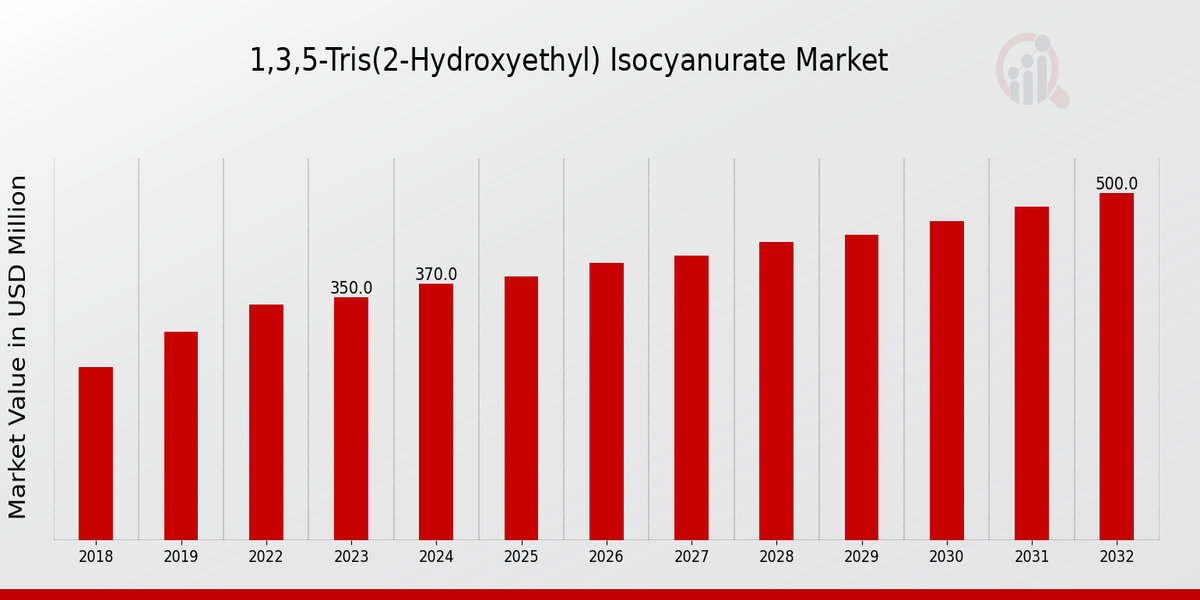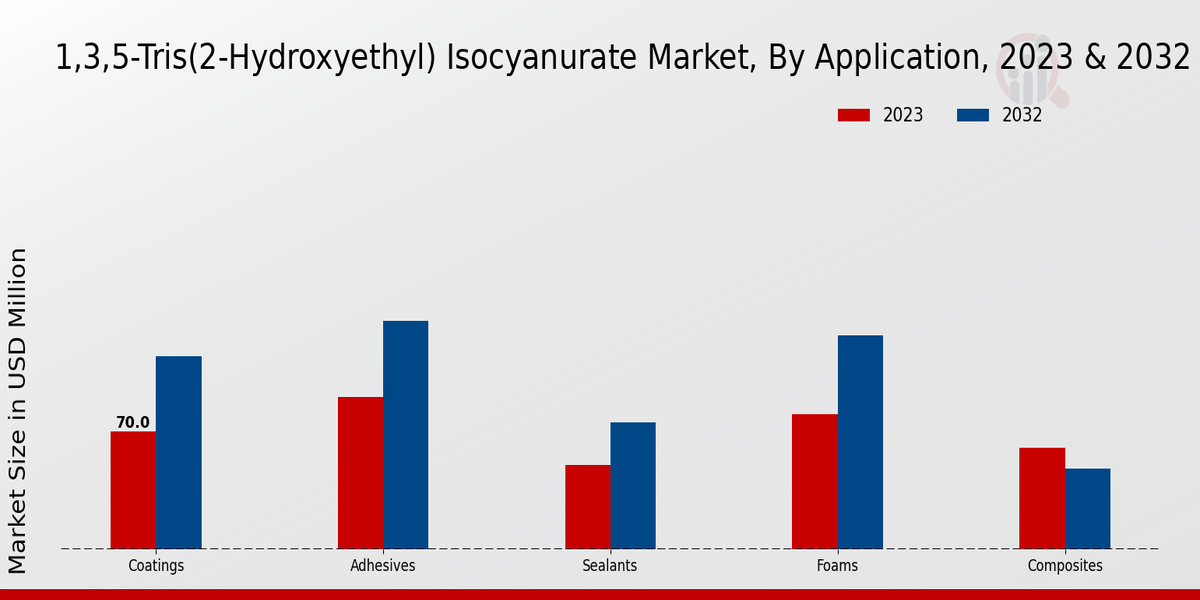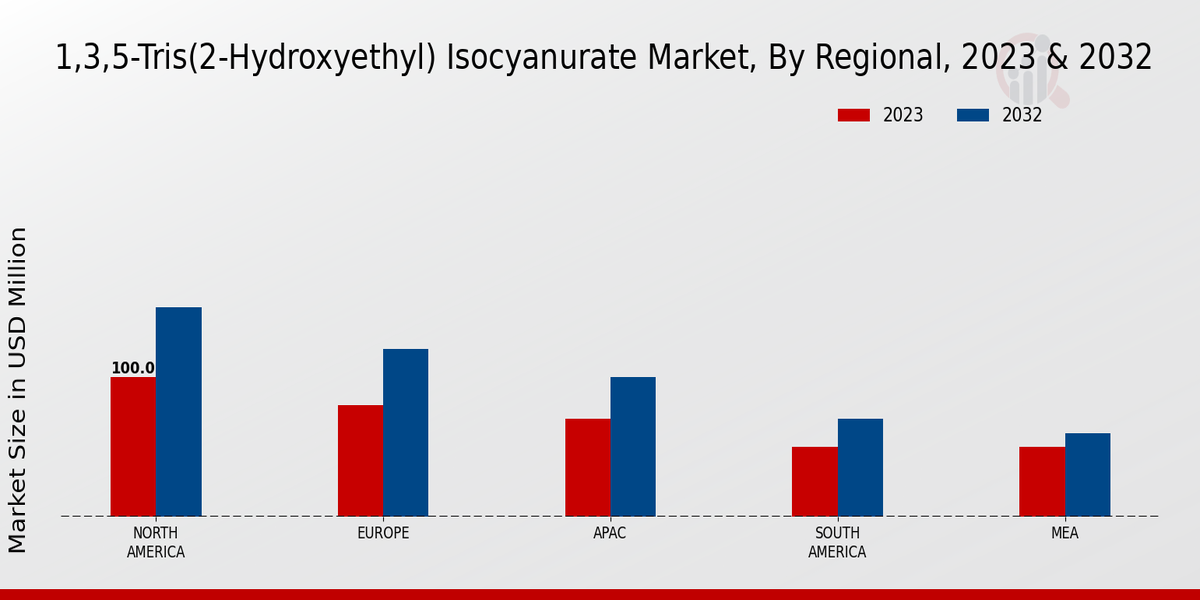Global 1,3,5-Tris(2-Hydroxyethyl) Isocyanurate Market Overview
The 1,3,5-Tris(2-Hydroxyethyl) Isocyanurate Market Size was estimated at 340.0 (USD Million) in 2022. The 1,3,5-Tris(2-Hydroxyethyl) Isocyanurate Industry is expected to grow from 0.35(USD Million) in 2023 to 500.0 (USD Million) by 2032. The 1,3,5-Tris(2-Hydroxyethyl) Isocyanurate Market CAGR (growth rate) is expected to be around 4.01% during the forecast period (2024 - 2032).
Key 1,3,5-Tris(2-Hydroxyethyl) Isocyanurate Market Trends Highlighted
The market for 1,3,5-Tris(2-Hydroxyethyl) Isocyanurate is driven by several key factors, including the rising demand for environmentally friendly and durable materials in various applications. This compound is increasingly favored in industries such as coatings, adhesives, and construction due to its excellent thermal stability and resistance to chemical degradation. The growing trend towards sustainability is pushing manufacturers to seek alternatives that reduce the environmental impact of traditional materials. Additionally, the expanding building and construction sector is contributing significantly to the demand for effective insulation materials, which further drives the market.There are substantial opportunities to be captured in the realm of product innovation and development, particularly in creating formulations that cater to specific industry requirements. As industries evolve, the need for specialized products that enhance performance while remaining eco-friendly presents a chance for companies to differentiate themselves. Expanding into emerging markets is another area of potential, as these regions see increased industrial activity and infrastructure development. Furthermore, partnerships with research institutions can foster innovation, leading to unique applications for 1,3,5-Tris(2-Hydroxyethyl) Isocyanurate.Recent trends show a notable shift towards the adoption of sustainable practices, with businesses focusing on minimizing their carbon footprints. There is also a rising awareness of health and safety standards, prompting companies to invest in safer materials that comply with regulations. The market is witnessing increased collaboration between key players to enhance their product offerings and enter new markets. As the focus on sustainability grows, businesses are likely to align their strategies with these values to remain competitive and meet the changing customer demands; thus, the landscape of the 1,3,5-Tris(2-Hydroxyethyl) Isocyanurate market is set for transformation in the coming years.

Source: Primary Research, Secondary Research, MRFR Database and Analyst Review
1,3,5-Tris(2-Hydroxyethyl) Isocyanurate Market Drivers
Growing Demand from End-Use Industries
The 1,3,5-Tris(2-Hydroxyethyl) Isocyanurate Market Industry is experiencing significant growth due to an increasing demand from various end-use industries, particularly in the realms of textiles and coatings. As industries focus on enhancing product quality and durability, the utilization of 1,3,5-Tris(2-Hydroxyethyl) Isocyanurate as a crosslinking agent becomes more prevalent. This compound not only improves the physical properties of the final products but also enhances their resistance to environmental stresses.The textile industry requires materials that are not only functional but also have aesthetic appeal, driving the need for chemicals that can provide the necessary properties without compromising the integrity of the fabrics. As consumers become more environmentally conscious, industries are also looking for sustainable and non-toxic solutions, which the 1,3,5-Tris(2-Hydroxyethyl) Isocyanurate can offer due to its favorable safety profile compared to traditional alternatives.With growing awareness regarding sustainable practices and the push towards eco-friendly materials, the demand from these sectors is anticipated to grow significantly over the coming years, thus driving the market forward.
Innovative Applications in the Construction Sector
The construction industry's evolving needs are introducing innovative applications for 1,3,5-Tris(2-Hydroxyethyl) Isocyanurate, making it a crucial driver in the 1,3,5-Tris(2-Hydroxyethyl) Isocyanurate Market Industry. As construction materials that enhance sustainability and thermal stability are in high demand, this compound is finding its way into various mixtures, including adhesives, sealants, and coatings. These applications ensure greater durability and overall performance, answering the industry's demands for longevity and efficiency.With green building practices taking precedence, the usage of such chemicals aligns perfectly with the sector's goals, further propelling its adoption and market growth.
Advancements in Production Technologies
Technological advancements in the production of 1,3,5-Tris(2-Hydroxyethyl) Isocyanurate are key to improving yield and efficiency, thereby positioning this 1,3,5-Tris(2-Hydroxyethyl) Isocyanurate Market Industry for significant expansion. Innovations in manufacturing processes are reducing costs and enhancing product quality, enabling companies to meet rising demands effectively. As production technologies evolve, producers can ensure consistent quality and adherence to safety regulations, making their offerings more appealing to a broader range of industrial applications.
1,3,5-Tris(2-Hydroxyethyl) Isocyanurate Market Segment Insights
1,3,5-Tris(2-Hydroxyethyl) Isocyanurate Market Application Insights
The 1,3,5-Tris(2-Hydroxyethyl) Isocyanurate Market exhibits significant commercial potential within the Application segment, showcasing a diverse landscape of uses across various industries. In 2023, the revenue for this segment was valued at 0.35 Million USD, and as the market progresses towards 2032, it aims for a remarkable valuation of 500.0 Million USD. This growth trajectory underscores the increasing demand for versatile materials that include 1,3,5-Tris(2-Hydroxyethyl) Isocyanurate due to its properties that meet various application requirements in diverse sectors. The coatings segment holds a notable position, with a revenue of 70.0 Million USD in 2023, forecasted to increase to 114.5 Million USD by 2032. This growth can be attributed to the rising need for protective and decorative finishes in the construction and automotive industries, where the chemical's durability and performance are essential. Following closely is the adhesives segment, valued at 90.0 Million USD in 2023 and projected to reach 135.2 Million USD by 2032, reflecting its critical role in manufacturing processes as it provides strong bonding capabilities essential for various applications, from furniture to automotive assemblies.
The sealants sector is also significant, starting at 50.0 Million USD in 2023 and aspiring to 75.3 Million USD by 2032, illustrating the ongoing need for effective sealing solutions across construction, automotive, and aerospace industries to ensure durability and integrity. Foams, valued at 80.0 Million USD in 2023, are anticipated to rise to 127.0 Million USD by 2032, driven by their application in insulation and cushioning, demonstrating the material's importance in energy conservation and comfort in various consumer goods. However, the composites segment shows a decline, with a valuation of 60.0 Million USD in 2023 and a prediction of reducing to 48.0 Million USD by 2032. This decline can suggest a shift in preference towards more advanced composite materials or highlight emerging alternatives that could impact the demand for traditional composites using 1,3,5-Tris(2-Hydroxyethyl) Isocyanurate. Overall, the 1,3,5-Tris(2-Hydroxyethyl) Isocyanurate Market revenue reflects a dynamic sector characterized by growth opportunities driven by innovation and market needs, while the segmentation reveals varied applications fueling this trend in diverse industrial landscapes. Market growth is further supported by increased awareness regarding energy-efficient materials, bolstered by advancements in technology that are enabling manufacturers to explore new applications and optimize formulations for enhanced performance. However, challenges remain, particularly in establishing standard formulations that leverage the advantages of 1,3,5-Tris(2-Hydroxyethyl) Isocyanurate against competing materials in specific use cases, impacting overall market penetration. In summary, the Application segment reflects the varied utility and significant growth potential of 1,3,5-Tris(2-Hydroxyethyl) Isocyanurate across critical industry sectors, driving a continued positive outlook for market expansion in the coming years.

Source: Primary Research, Secondary Research, MRFR Database and Analyst Review
1,3,5-Tris(2-Hydroxyethyl) Isocyanurate Market End Use Industry Insights
The 1,3,5-Tris(2-Hydroxyethyl) Isocyanurate Market, valued at 0.35 million USD in 2023, demonstrates significant potential for growth across various end-use industries. The market is characterized by its robust segmentation into four primary functions: Construction, Automotive, Aerospace, and Consumer Goods. The construction sector is crucial, utilizing this compound for its excellent adhesive and insulation properties, thereby enhancing energy efficiency in buildings. In the automotive industry, the product plays a vital role in improving vehicle safety and performance.Meanwhile, the aerospace segment emphasizes lightweight and durable materials, making 1,3,5-Tris(2-Hydroxyethyl) Isocyanurate vital for aircraft manufacturing. The consumer goods sector also heavily incorporates this chemical for coatings and various durable goods, contributing to its significant market presence. The 1,3,5-Tris(2-Hydroxyethyl) Isocyanurate Market statistics reveal a steady demand across these industries, influenced by trends toward sustainability and increased regulatory support for safer materials. The compound's versatility presents numerous growth opportunities, notwithstanding challenges such as fluctuating raw material costs and the need for regulatory compliance across different regions.
1,3,5-Tris(2-Hydroxyethyl) Isocyanurate Market Formulation Type Insights
The 1,3,5-Tris(2-Hydroxyethyl) Isocyanurate Market, valued at 0.35 Million USD in 2023, showcases diverse formulation types that contribute significantly to the overall market dynamics. The formulation types, mainly Water-Based, Solvent-Based, and Hot Melt, are essential in different industrial applications due to their unique properties. Water-Based formulations are gaining popularity as they are environmentally friendly and offer ease of application, capturing notable market attention. Solvent-based formulations, on the other hand, retain a significant share owing to their superior adhesion and durability, making them a preferred choice for robust industrial applications.Hot Melt formulations are also critical, particularly in sectors requiring quick setting times and efficiency. As the 1,3,5-Tris(2-Hydroxyethyl) Isocyanurate Market continues to evolve, understanding the performance and capabilities of these formulation types is key to leveraging growth opportunities while navigating challenges such as regulatory requirements and material costs, ultimately shaping the market landscape.
1,3,5-Tris(2-Hydroxyethyl) Isocyanurate Market Chemical Composition Insights
The 1,3,5-Tris(2-Hydroxyethyl) Isocyanurate Market is exhibiting substantial growth, particularly in the Chemical Composition segment, projected to achieve a market value of 0.35 million USD in 2023. With expectations of significant expansion leading up to 2032, the market is characterized by a steady growth rate. The Chemical Composition encompasses various formulations such as Polymer-Coated, Non-Polymer Coated, and Modified categories, which play a crucial role in enhancing the applications of 1,3,5-Tris(2-Hydroxyethyl) Isocyanurate. The Polymer-Coated type is increasingly favored for its improved durability and effectiveness in various settings, making it a dominant choice in industrial applications.Conversely, the Non-Polymer Coated category attracts attention for its cost-effectiveness and versatility across numerous applications. Meanwhile, the Modified variant is gaining traction due to customizable properties that cater to specific needs in diverse industries. This diversity in the Chemical Composition underscores the growing adaptability and innovation within the 1,3,5-Tris(2-Hydroxyethyl) Isocyanurate Market. Additionally, the market faces challenges such as fluctuating raw material prices and stringent regulatory frameworks, but it is also poised to benefit from rising demand in sectors including construction, automotive, and consumer goods.
1,3,5-Tris(2-Hydroxyethyl) Isocyanurate Market Regional Insights
The 1,3,5-Tris(2-Hydroxyethyl) Isocyanurate Market exhibited a valuation of 0.35 USD Million in 2023, with expected growth propelling it significantly to 500.0 USD Million by 2032. Within the regional landscape, North America holds a majority share, valued at 100.0 USD Million in 2023, and is projected to reach 150.0 USD Million by 2032, highlighting its dominance driven by robust demand from industries such as construction and automotive. Europe follows closely, valued at 80.0 USD Million in 2023, with a significant rise to 120.0 USD Million anticipated by 2032, owing to increased regulatory standards concerning fire safety.The APAC region is emerging prominently, valued at 70.0 USD Million in 2023, showcasing growth potential as manufacturing and industrial sectors expand. South America and MEA both show lower valuations at 50.0 USD Million each in 2023, with smaller growth prospects, reaching 70.0 USD Million and 60.0 USD Million, respectively, by 2032; however, they present opportunities for market penetration as infrastructure development progresses. The 1,3,5-Tris(2-Hydroxyethyl) Isocyanurate Market's segmentation underscores significant geographic variations in market dynamics, reflecting both current valuations and future growth trajectories across different regions.

Source: Primary Research, Secondary Research, MRFR Database and Analyst Review
1,3,5-Tris(2-Hydroxyethyl) Isocyanurate Market Key Players and Competitive Insights
The competitive landscape of the 1,3,5-Tris(2-Hydroxyethyl) Isocyanurate Market is characterized by a diverse array of players who are leveraging their unique capabilities to capture market share and enhance technological advancements. This market, known for its applications in various industries, including coatings, adhesives, and textiles, is witnessing an uptick in demand due to rising awareness regarding product performance and environmental sustainability. The competition is intensified not only by the quality and innovation of products offered but also by strategic initiatives such as mergers, acquisitions, partnerships, and collaborations among key industry stakeholders. Companies are increasingly investing in research and development to create enhanced formulations that meet the stringent requirements of end-use applications while also complying with regulatory standards.Kraton Corporation has established a significant presence in the 1,3,5-Tris(2-Hydroxyethyl) Isocyanurate Market, leveraging its strong reputation for high-quality products and innovation. The company excels in producing thermoplastic elastomers and specialty polymers that cater to diverse applications. One of Kraton's key strengths is its focus on sustainability and environmentally friendly solutions, which resonates well with current market trends. Additionally, Kraton's robust distribution network allows it to effectively reach markets, thereby enhancing its competitive advantage. The company's commitment to research and development fosters continuous improvement of its product portfolio, allowing it to meet the evolving demands of customers across various applications in the isocyanurate sector.Mitsubishi Gas Chemical Company also plays a pivotal role in the 1,3,5-Tris(2-Hydroxyethyl) Isocyanurate Market, known for its technological prowess and commitment to quality. The company adopts a strategic approach by investing in advanced production techniques and innovative product development to stay ahead in a highly competitive landscape. Mitsubishi Gas Chemical's significant investment in research emphasizes its goal of producing high-performance materials that exceed the expectations of users while also adhering to regulatory compliance. Strong collaborations and partnerships within the industry further enable Mitsubishi Gas Chemical to expand its reach ly, offering tailored solutions that cater to specific industry needs. The company's ability to adapt to market trends while maintaining a high standard of quality positions it as a formidable competitor in this dynamic market.
Key Companies in the 1,3,5-Tris(2-Hydroxyethyl) Isocyanurate Market Include
- Kraton Corporation
- Mitsubishi Gas Chemical Company
- Wanhua Chemical Group
- Solvay SA
- Huntsman Corporation
- SABIC
- Albermarle Corporation
- BASF SE
- Momentive Performance Materials Inc
- ShinEtsu Chemical Co Ltd
- Evonik Industries AG
- DOW Inc
- Covestro AG
- Clariant AG
1,3,5-Tris(2-Hydroxyethyl) Isocyanurate Market Industry Developments
Recent developments in the 1,3,5-Tris(2-Hydroxyethyl) Isocyanurate Market have shown a notable emphasis on sustainability and innovation, driven by leading players such as Kraton Corporation, Mitsubishi Gas Chemical Company, and Wanhua Chemical Group. There is a growing demand for eco-friendly alternatives, which has prompted companies like Solvay SA and Huntsman Corporation to expand their product offerings in response to environmental regulations. Moreover, SABIC and Albermarle Corporation are investing in R&D to enhance production efficiency and improve the performance characteristics of their products. In terms of mergers and acquisitions, BASF SE's recent acquisition strategy aims to consolidate its presence across the isocyanurate spectrum, enhancing its competitive edge. Additionally, Momentive Performance Materials Inc. and ShinEtsu Chemical Co. Ltd are also exploring strategic partnerships to diversify their technological capabilities. The market valuation of firms in this sector is experiencing growth, indicating increased consumer interest and application scope, which further incentivizes investment in manufacturing capacities. As companies aim to secure market share and maximize profitability, these trends reflect a dynamic landscape shaped by regulatory pressures and innovative advancements.
1,3,5-Tris(2-Hydroxyethyl) Isocyanurate Market Segmentation Insights
1,3,5-Tris(2-Hydroxyethyl) Isocyanurate Market Application Outlook
- Coatings
- Adhesives
- Sealants
- Foams
- Composites
1,3,5-Tris(2-Hydroxyethyl) Isocyanurate Market End Use Industry Outlook
- Construction
- Automotive
- Aerospace
- Consumer Goods
1,3,5-Tris(2-Hydroxyethyl) Isocyanurate Market Formulation Type Outlook
- Water-Based
- Solvent-Based
- Hot Melt
1,3,5-Tris(2-Hydroxyethyl) Isocyanurate Market Chemical Composition Outlook
- Polymer-Coated
- Non-Polymer Coated
- Modified
1,3,5-Tris(2-Hydroxyethyl) Isocyanurate Market Regional Outlook
- North America
- Europe
- South America
- Asia Pacific
- Middle East and Africa
| Report Attribute/Metric |
Details |
| Market Size 2022 |
340.0(USD Million) |
| Market Size 2023 |
0.35(USD Million) |
| Market Size 2032 |
500.0(USD Million) |
| Compound Annual Growth Rate (CAGR) |
4.01% (2024 - 2032) |
| Report Coverage |
Revenue Forecast, Competitive Landscape, Growth Factors, and Trends |
| Base Year |
2023 |
| Market Forecast Period |
2024 - 2032 |
| Historical Data |
2019 - 2023 |
| Market Forecast Units |
USD Million |
| Key Companies Profiled |
Kraton Corporation, Mitsubishi Gas Chemical Company, Wanhua Chemical Group, Solvay SA, Huntsman Corporation, SABIC, Albermarle Corporation, BASF SE, Momentive Performance Materials Inc, ShinEtsu Chemical Co Ltd, Evonik Industries AG, DOW Inc, Covestro AG, Clariant AG |
| Segments Covered |
Application, End Use Industry, Formulation Type, Chemical Composition, Regional |
| Key Market Opportunities |
Rising demand in the construction industry, Growth in automotive applications, Increasing use in adhesives, Expansion in the coatings sector, and Advancements in renewable materials. |
| Key Market Dynamics |
Increasing demand in coatings, Growing construction activities, Rising adoption of adhesives, Environmental regulations favoring eco-friendly products, Technological advancements in manufacturing processes |
| Countries Covered |
North America, Europe, APAC, South America, MEA |
Frequently Asked Questions (FAQ) :
The 1,3,5-Tris(2-Hydroxyethyl) Isocyanurate Market is expected to be valued at 500.0 USD Million by 2032.
The expected CAGR for the 1,3,5-Tris(2-Hydroxyethyl) Isocyanurate Market from 2024 to 2032 is 4.01%.
North America is anticipated to have the largest market share, valued at 150.0 USD Million in 2032.
The market size for the Coatings application is expected to reach 114.5 USD Million by 2032.
Major players include Kraton Corporation, Mitsubishi Gas Chemical Company, Wanhua Chemical Group, Solvay SA, and Huntsman Corporation.
The expected market value for the Adhesives application is projected to reach 135.2 USD Million by 2032.
The South American market is expected to be valued at 70.0 USD Million in 2032.
The forecasted market size for the Foams application is anticipated to be 127.0 USD Million by 2032.
The Sealants application is estimated to be valued at 75.3 USD Million in 2032.
The market value for the Composites application is anticipated to reach 48.0 USD Million by 2032.





























